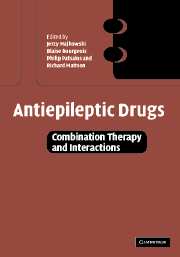Book contents
- Frontmatter
- Contents
- List of contributors
- Foreword
- Foreword
- Acknowledgements
- Part I Introduction
- Part II Pharmacokinetic interactions
- Part III Pharmacodynamic interactions
- Part IV Drug interactions in specific patient populations and special conditions
- 14 Antiepileptic drug interactions in children
- 15 Antiepileptic drug interactions in the elderly
- 16 Antiepileptic drug interactions in pregnancy
- 17 Antiepileptic drug interactions in handicapped and mentally retarded patients
- 18 Antiepileptic drugs and sex steroids
- 19 Antiepileptic drug interactions in patients requiring psychiatric drug treatment
- 20 Antiepileptic drugs in non-epileptic health conditions: possible interactions
- 21 Drug monitoring in combination therapy
- 22 Cognitive side-effects due to antiepileptic drug combinations and interactions
- Part V Conclusions and future perspectives
- Index
19 - Antiepileptic drug interactions in patients requiring psychiatric drug treatment
from Part IV - Drug interactions in specific patient populations and special conditions
Published online by Cambridge University Press: 07 September 2009
- Frontmatter
- Contents
- List of contributors
- Foreword
- Foreword
- Acknowledgements
- Part I Introduction
- Part II Pharmacokinetic interactions
- Part III Pharmacodynamic interactions
- Part IV Drug interactions in specific patient populations and special conditions
- 14 Antiepileptic drug interactions in children
- 15 Antiepileptic drug interactions in the elderly
- 16 Antiepileptic drug interactions in pregnancy
- 17 Antiepileptic drug interactions in handicapped and mentally retarded patients
- 18 Antiepileptic drugs and sex steroids
- 19 Antiepileptic drug interactions in patients requiring psychiatric drug treatment
- 20 Antiepileptic drugs in non-epileptic health conditions: possible interactions
- 21 Drug monitoring in combination therapy
- 22 Cognitive side-effects due to antiepileptic drug combinations and interactions
- Part V Conclusions and future perspectives
- Index
Summary
Classification of psychotropic drugs
Antidepressant drugs
Everybody is familiar with the tricyclic antidepressant drugs (TCAs). However, in recent years a number of newer antidepressant drugs have been introduced into clinical practice (Table 19.1). Essentially these are mainly non-tricyclic, earlier variants included mianserin, maprotiline and viloxazine.
The selective serotonin re-uptake inhibitors (SSRIs) are represented by citalopram, fluoxetine, fluvoxamine, sertraline and paroxetine. Of these, citalopram is the most selective on serotonergic uptake, inhibiting serotonin uptake 3000 times more than noradrenaline uptake, and 22,000 times more than that of dopamine. In general, the SSRIs are better tolerated and safer in overdose when compared with tricyclic drugs.
The latest generation of antidepressants has been developed to derive therapeutic benefits from tailor-made actions at specific monoamine receptor and re-uptake sites, in theory providing better efficacy and tolerability.
Reboxetine is a selective noradrenergic re-uptake inhibitor (NARI) with low affinity for histaminergic, cholinergic, dopaminergic and alpha-1 adrenergic receptors. It appears to be equally as effective as the tricyclics in treating depression, and there is a suggestion that it may be more effective than fluoxetine (Montgomery, 1997). Venlafaxine is a serotonin-noradrenergic re-uptake inhibitor (NSRI), which is similar to the earlier generation of antidepressants, but it does not interact with histaminergic or cholinergic receptors, thus diminishing side effects due to those receptor systems. Several studies have indicated equipotentiality or superior effectiveness with this compound compared with tricyclics (Burnett and Dinan, 1994).
Keywords
- Type
- Chapter
- Information
- Antiepileptic DrugsCombination Therapy and Interactions, pp. 350 - 368Publisher: Cambridge University PressPrint publication year: 2005
- 4
- Cited by

